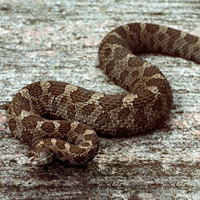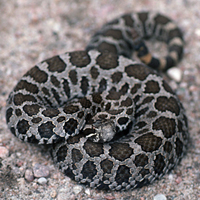Massasauga rattlesnake
Scientific name: Sistrurus catenatus


Cover photos credit: JD Taylor
Status
Threatened (Great Lakes - St. Lawrence population)
"Threatened" means the species lives in the wild in Ontario, is not endangered, but is likely to become endangered if steps are not taken to address factors threatening it.
Endangered (Carolinian population)
"Endangered" means the species lives in the wild in Ontario but is facing imminent extinction or extirpation.
Date added to the Species at Risk in Ontario List
The Massasauga Rattlesnake was listed as threatened when the Endangered Species Act took effect in 2008. On June 27, 2014, the population was split into two, with the Great Lakes – St. Lawrence population listed as threatened, and the Carolinian population listed as endangered.
Read the report – Great Lakes – St. Lawrence population (PDF)
Read the report – Carolinian population (PDF)
What it looks like
The Massasauga is a stout-bodied rattlesnake, usually about 50 to 70 centimetres long. It is Ontario’s only venomous snake, though it will only bite in self-defence if it is threatened or harassed. It has a triangular head and a tail that ends in a small rattle that creates a buzzing sound when the tail shakes. The body is grey to dark brown with darker brown "butterfly" or "saddle-shaped" blotches down the back, with alternating blotches along the sides. The Massasauga is the only Ontario snake with a vertical (cat-like) pupil.
Where it lives
Massasaugas live in different types of habitats throughout Ontario, including tall grass prairie, bogs, marshes, shorelines, forests and alvars. Within all of these habitats, Massasaugas require open areas to warm themselves in the sun. Pregnant females are most often found in open, dry habitats such as rock barrens or forest clearings where they can more easily maintain the body temperature required for the development of their offspring. Non-pregnant females and males forage and mate in lowland habitats such as grasslands, wetlands, bogs and the shorelines of lakes and rivers. Massasaugas hibernate underground in crevices in bedrock, sphagnum swamps, tree root cavities and animal burrows where they can get below the frost line but stay above the water table.
Where it’s been found in Ontario
In Canada, the Massasauga is found only in Ontario, primarily along the eastern side of Georgian Bay and on the Bruce Peninsula. Two small populations are also found in the Wainfleet Bog on the northeast shore of Lake Erie and near Windsor. The Massasauga was once more widespread in southwestern Ontario, especially along the shores of the Great Lakes.
What threatens it
The most significant threats to the Massasauga are persecution by humans, mortality on roads, and loss of habitats. These threats led to the disappearance of this species from most of its historic range in southwestern Ontario.
Action we are taking
Threatened species and their general habitat are automatically protected.
Recovery strategy
A recovery strategy advises the ministry on ways to ensure healthy numbers of the species return to Ontario.
Read the executive summary and full document (May 31, 2016)
Government response statement
A government response statement outlines the actions the government intends to take or support to help recover the species.
Read the government response statement (December 21, 2018)
Review of Progress
A review of progress made toward protecting and recovering a species is required no later than the time specified in the species’ government response statement, or not later than five years after the government response statement is published if no time is specified.
Read the report on progress towards the protection and recovery of 11 species at risk, including Massasauga (2023).
Habitat protection
General habitat descriptions are technical, science-based documents that provide greater clarity on the area of habitat protected for a species.
Read the general habitat description (July 2, 2013).
General habitat protection - June 30, 2013
What you can do
Report a sighting
- Report a sighting of an endangered animal or plant to the Natural Heritage Information Centre. Photographs with specific locations or mapping coordinates are always helpful.
- the Ontario Reptile and Amphibian Atlas also collects observations of all Ontario reptiles and amphibians. Submit your observations at: www.ontarionature.org/atlas.
Volunteer
Volunteer with your local nature club or provincial park to participate in surveys or stewardship work focused on species at risk.
Be a good steward
- private land owners have a very important role to play in species recovery; you may be eligible for stewardship programs that support the protection and recovery of species at risk and their habitats
- every year, snakes all over the province must cross busy roads; watch for snakes on the road, especially between May and October when they are most active
- appreciate snakes and don't harm them; sadly, people continue to deliberately kill snakes
- keep the danger of snakes in perspective: all of Ontario’s snakes are non-venomous, except for the very rare Massasauga
- take a few easy steps to protect yourself while hiking in known Massasauga habitat (e.g., the Bruce Peninsula); wear leather hiking boots and loose-fitting long pants; when in Massasauga habitat, always watch where you are walking and never reach into areas that you cannot see
- if you come across a snake, please don't try to capture it, handle it or kill it; snakes can be delicate and improper handling can cause serious injury; also, certain species are protected under legislation, which makes it illegal to harass, harm or kill them - be respectful and observe from a distance
- if you are bitten by a Massasauga, remain calm and call emergency services; never try to catch or kill the snake; it is unnecessary, dangerous and illegal
Report illegal activity
- report any illegal activity related to plants and wildlife to
1-877-TIP-SMNR (847-7667) - never buy snakes that have been caught in the wild and never buy a native species of any kind that’s being sold as a pet
Quick facts
- no one has died from a Massasauga bite in Ontario in more than 50 years, and only two deaths resulting from a Massasauga bite have ever been reported in the province
- a snake’s rattle is made up of loosely attached pieces of keratin (the same material that our fingernails are made from) that knock against each other and create a rattle or buzzing sound when the tail is shaken
- although the Massasauga is Ontario’s only rattlesnake, it’s not the only one that vibrates its tail; the Eastern foxsnake and Eastern milksnake are non-venomous snakes that mimic the rattlesnake by quickly vibrating the tip of their tails; if the tail comes into contact with leaf litter as it’s vibrating, it can make a buzzing sound
- the Massasauga is very shy and prefers to hide or retreat from enemies rather than bite them; if threatened, it will shake its tail as a warning and strike only as a last resort to protect itself if it can not escape
- sometimes the Massasauga will share its hibernation sites with other hibernating snakes, amphibians and even crayfish